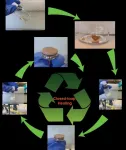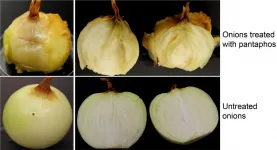Deforestation's effects on malaria rates vary by time and distance
Study shows that deforestation in Southeast Asia increases malaria infections before leading to later reductions, although these effects can vary by the location of forest loss
2021-03-09
(Press-News.org) Deforestation may cause an initial increase in malaria infections across Southeast Asia before leading to later decreases, a study published today in eLife suggests.
The results may help malaria control programs in the region develop better strategies for eliminating malaria infections and educating residents on how to protect themselves from infection.
Mosquitos spread the malaria parasite to humans causing infections that can be severe and sometimes deadly. In the area along the Mekong river in Southeast Asia, many residents hunt or harvest wood in the surrounding forests, which can increase their risk of infection. Yet recent outbreaks of malaria in the region have also been linked to deforestation.
"As countries in the region focus their malaria control and elimination efforts on reducing forest-related transmission, understanding the impact of deforestation on malaria rates is essential," says first author Francois Rerolle, Graduate Student Researcher at the University of California San Francisco (UCSF), US, who works within the UCSF Malaria Elimination Initiative.
To better understand the effects of deforestation on malaria transmission, Rerolle and colleagues examined both forest cover data and village-level malaria incidence data from 2013-2016 in two regions within the Greater Mekong Sub-region.
They found that in the first two years following deforestation activities, malaria infections increased in villages in the area, but then decreased in later years. This trend was mostly driven by infections with the malaria parasite Plasmodium falciparum. Deforestation in the immediate 1-10-kilometer radius surrounding villages did not affect malaria rates, but deforestation in a wider 30-kilometer radius around the villages did. The authors say this is likely due to the effect that wider deforestation can have on human behaviour. "We suspect that people making longer and deeper trips into the forest results in increased exposure to mosquitoes, putting forest-goers at risk," Rerolle explains.
Previously, studies on the Amazon in South America have found increased malaria infections in the first 6-8 years after deforestation, after which malaria rates fall. The difference in timing may be due to regional differences. The previous studies in the Amazon looked at deforestation driven by non-indigenous people moving deeper into the forest, while communities in the current study have long lived at the forest edges and rely on subsistence agriculture.
"Our work provides a more complete picture of the nuanced effects of deforestation on malaria infections," says senior author Adam Bennett, Program Lead at the UCSF Malaria Elimination Initiative. "It may encourage more in-depth studies on the environmental and behavioural drivers of malaria to help inform strategies for disease elimination."
INFORMATION:
Media contact
Emily Packer, Media Relations Manager
eLife
e.packer@elifesciences.org
+44 (0)1223 855373
About eLife
eLife is a non-profit organisation created by funders and led by researchers. Our mission is to accelerate discovery by operating a platform for research communication that encourages and recognises the most responsible behaviours. We aim to publish work of the highest standards and importance in all areas of biology and medicine, including Epidemiology and Global Health, while exploring creative new ways to improve how research is assessed and published. eLife receives financial support and strategic guidance from the Howard Hughes Medical Institute, the Knut and Alice Wallenberg Foundation, the Max Planck Society and Wellcome. Learn more at https://eLifesciences.org/about.
To read the latest Epidemiology and Global Health research published in eLife, visit https://eLifesciences.org/subjects/epidemiology-global-health.
About the UCSF Malaria Elimination Initiative
The Malaria Elimination Initiative works in partnership with malaria endemic countries and regions to advance evidence-based malaria policy and practice. Learn more at http://www.shrinkingthemalariamap.org.
ELSE PRESS RELEASES FROM THIS DATE:
2021-03-09
As the fight against COVID-19 continues, scientists have turned to an unlikely source for a potentially effective treatment: tiny antibodies naturally generated by llamas.
While the world has welcomed the news of multiple vaccines against COVID-19, the search for effective treatments for those who contract the virus is ongoing. Now scientists are looking to what might seem to be an unlikely source: the South American llama.
Researchers are using the ultrabright X-rays of the Advanced Photon Source (APS), a U.S. Department of Energy (DOE) Office of Science User Facility at DOE's Argonne National Laboratory, to help turn naturally generated llama antibodies into potentially effective therapies against ...
2021-03-09
Every 12 minutes, someone in the United States dies of pancreatic cancer, which is often diagnosed late, spreads rapidly and has a five-year survival rate at approximately 10 percent. Treatment may involve radiation, surgery and chemotherapy, though often the cancer becomes resistant to drugs.
Researchers at University of California San Diego School of Medicine and Moores Cancer Center, in collaboration with Sanford-Burnham-Prebys Medical Discovery Institute and Columbia University, demonstrated that a new tumor-penetrating therapy, tested in animal models, may enhance the effects of chemotherapy, reduce metastasis ...
2021-03-09
Computational models of air quality have long been used to shed light on pollution control efforts in the United States and Europe, but the tools have not found widespread adoption in Latin America. New work from North Carolina State University and Universidad de La Salle demonstrates how these models can be adapted to offer practical insights into air quality challenges in the Americas outside the U.S.
Computational air quality models can be used in multiple ways. For example, they can be used to determine which sources are responsible for what fraction of air pollution. They can also help authorities predict how air pollution might change if different pollution control methods are adopted.
"Historically, it's been very challenging to apply these modeling ...
2021-03-09
Polymer scientists from the University of Groningen and NHL Stenden University of Applied Sciences, both in the Netherlands, have developed a polymer membrane from biobased malic acid. It is a superamphiphilic vitrimer epoxy resin membrane that can be used to separate water and oil. This membrane is fully recyclable. When the pores are blocked by foulants, it can be depolymerized, cleaned and subsequently pressed into a new membrane. A paper describing the creation of this membrane was published in the journal Advanced Materials on 7 March 2021.
How do you clean up an oil spill in ...
2021-03-09
Study Reveals New Hope for Men With Common Urinary Issues
A new systematic review of evidence recommends the use of behavioral self-management treatments for common urinary issues experienced by upwards of 70 percent of older men. Common symptoms include trouble urinating, increased frequency and incontinence. These symptoms can have a substantial negative impact on sleep, social functioning and quality of life. Several guidelines recommend self-management techniques like health education, advice on fluid intake, and bladder retraining; however, in practice, self-management is often excluded from the menu of treatment options that include medication and surgery.
Researchers at Bond University's Institute for Evidence-Based Healthcare found that ...
2021-03-09
What would a truly progressive city look like? A city that pays more than lip service to issues that directly affect low-income residents, seniors, marginalized communities and others whom neoliberal policies have seemingly left behind? ...
2021-03-09
Since 1983, the bacteria Pantoea ananatis has been known to infect several important crops including onions, rice, and corn. It was unclear, however, what molecules were involved. A new study, published in mBio, has identified one of the culprits: pantaphos. Intriguingly, the researchers have discovered that pantaphos can also act as an herbicide and it is toxic to glioblastoma cells, making it an exciting candidate for agricultural and biomedical applications.
"Herbicide resistant weeds are an issue in agriculture," said William Metcalf (MMG leader), a professor of microbiology. "Unfortunately, there hasn't been a new class of herbicide ...
2021-03-09
CHAPEL HILL, NC -- A comprehensive review by University of North Carolina researchers and colleagues of hundreds of publications, incorporating more than two dozen articles on prevention screening for lung cancer with low-dose spiral computed tomography (LDCT), shows there are both benefits and harms from screening. The review is published in JAMA on March 9, 2021.
The results of the decadelong National Lung Screening Trial (NLST) showed that LDCT could detect lung cancer better than conventional X-rays in current or previous heavy smokers. Based on those results, the United States Preventive Services ...
2021-03-09
WASHINGTON, March 9, 2021 -- The University of Minnesota School of Music was concerned about one-on-one teaching during the COVID-19 pandemic and wondered if it should supplement its ventilation system with portable HEPA air purifiers.
So, school officials reached out to Suo Yang, a professor within the College of Science and Engineering, and his team to figure it out. In Physics of Fluids, from AIP Publishing, Yang and the researchers describe their work to predict how virus particles spread within a music classroom.
"The airborne transmission of COVID-19 through ...
2021-03-09
By closely examining the jaw mechanics of juvenile and adult tyrannosaurids, some of the fiercest dinosaurs to inhabit earth, scientists led by the University of Bristol have uncovered differences in how they bit into their prey.
They found that younger tyrannosaurs were incapable of delivering the bone-crunching bite that is often synonymous with the Tyrannosaurus Rex and that adult specimens were far better equipped for tearing out chunks of flesh and bone with their massive, deeply set jaws.
The team also found that tension from the insertion of the lower pterygoid muscle is linked to decreasing stresses near the front of the typical tyrannosaur jaw, where the animals may have applied their highest impact bite ...
LAST 30 PRESS RELEASES:
[Press-News.org] Deforestation's effects on malaria rates vary by time and distance
Study shows that deforestation in Southeast Asia increases malaria infections before leading to later reductions, although these effects can vary by the location of forest loss






